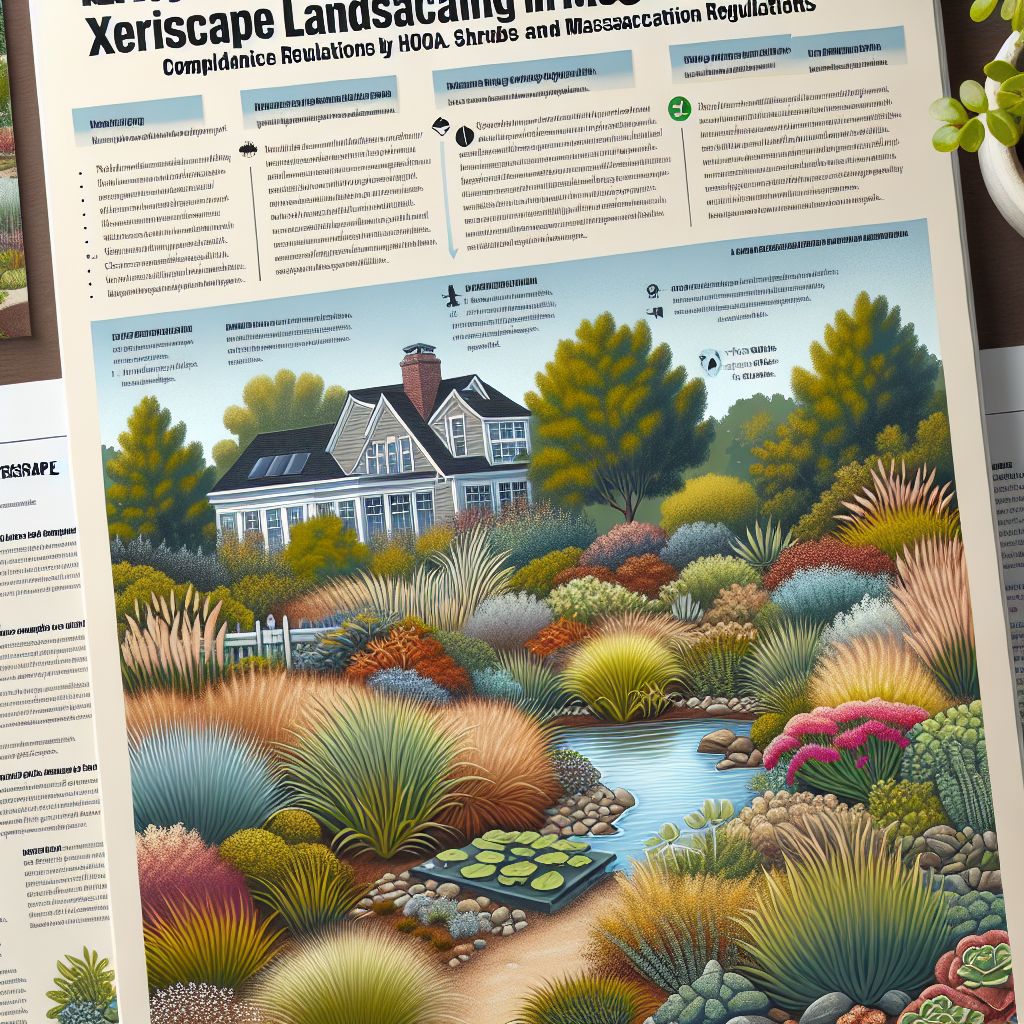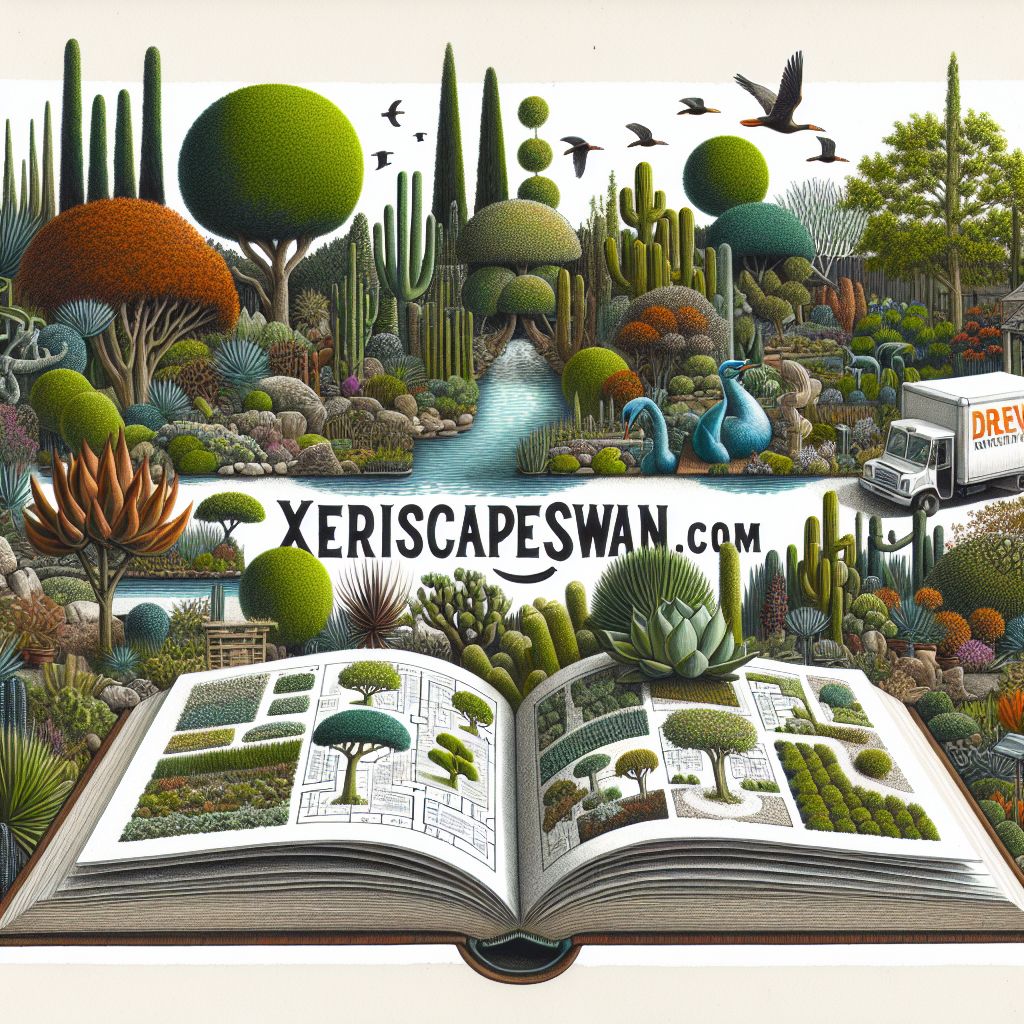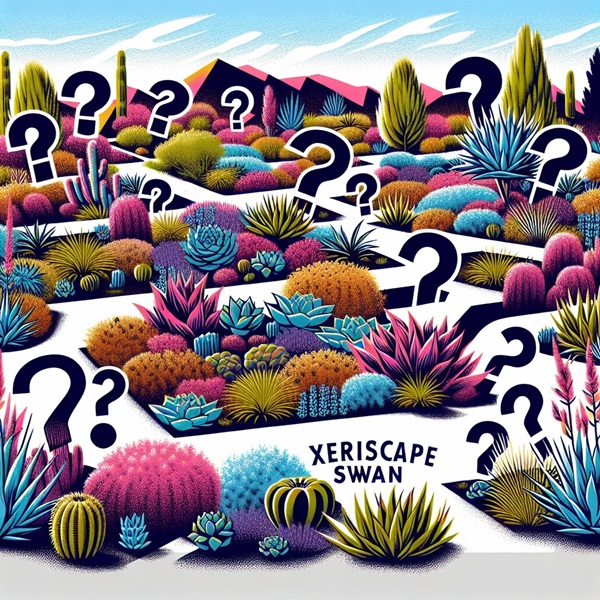
Key Takeaways
- Xeriscaping in Massachusetts can be both eco-friendly and HOA compliant, focusing on water conservation and plant selection.
- Understanding your local HOA’s landscaping regulations is crucial to creating a successful xeriscape design.
- Choosing native and drought-tolerant plants is essential for a resilient garden that requires minimal water.
- Efficient irrigation and mulching are key components of
, helping to reduce water usage and maintain soil health. - Regular maintenance, though reduced compared to traditional landscaping, is important to keep your xeriscape thriving.
Quick Overview: Embracing Eco-Friendly Xeriscaping While Meeting HOA Standards
Massachusetts, with its varied climate, presents a unique opportunity for homeowners to adopt xeriscaping—the practice of creating landscapes that reduce or eliminate the need for supplemental water from irrigation. Despite what some may think, xeriscaping is not about having a dull or barren garden; it’s about making smart, sustainable choices that align with local ecosystems. And yes, it’s possible to do this while staying within the guidelines of your Homeowners’ Association (HOA).
Let’s dive into the basics of xeriscaping and how to navigate HOA regulations to create a beautiful, water-wise landscape that benefits your pocket and the planet.
Xeriscape Basics: Water Conservation Meets Beauty
At its core, xeriscaping is about planning. It’s about choosing plants that thrive in your local climate without needing extra water. In Massachusetts, this means looking at the weather patterns—winters can be cold and snowy, while summers are warm and can be quite humid. A well-designed xeriscape will take these conditions into account, using plants that are adapted to the local environment and that will flourish with the rainfall nature provides.
Common HOA Concerns and How to Address Them
Homeowners’ Associations often have specific guidelines for landscaping to maintain a certain aesthetic in the community. These may include restrictions on the types of plants you can use, the amount of lawn you must have, and even the kind of mulch. The key is to understand these rules and work within them to create your xeriscape. Communication with your HOA is essential, as is providing a detailed plan that shows how your design will enhance the community’s appearance while being environmentally responsible. For more information, refer to this comprehensive HOA Landscaping Guide for Homeowners.
Designing with Sustainability and Compliance in Mind
When designing your xeriscape, consider both the sustainability of your choices and the need to comply with your HOA’s standards. Start with a plan that includes native plants, which are more likely to be accepted by your HOA and will require less water and maintenance. Also, look at sustainable materials for hardscaping and choose efficient irrigation systems that can be easily hidden or made aesthetically pleasing to meet HOA requirements.
Next, let’s delve into the essential components of xeriscaping that marry conservation with aesthetics, ensuring that your landscape is not only eco-friendly but also visually appealing and HOA approved.
Zoning Your Garden: Creating Microclimates
Imagine your garden as a patchwork of different zones, each with its own microclimate. These zones are areas in your garden that have unique characteristics regarding sunlight, wind, and moisture. In Massachusetts, you might have a sunny spot that gets blasted by the winter winds, or a shady area under a tree that stays cool and moist. By identifying these zones, you can select plants that are suited to each specific area, reducing the need for watering and maintenance.
For example, place drought-resistant plants in sunny, dry areas, and moisture-loving plants in areas that retain water longer. This strategic placement helps your garden thrive naturally, which is exactly what xeriscaping is about. And when you present this plan to your HOA, they’ll see that you’ve thoughtfully considered the design, which often leads to approval.
Mulching and Soil Management: Foundations for Success
Mulch is your secret weapon in a xeriscape garden. It conserves water by keeping the soil cool and moist, reduces weed growth, and adds a polished look to your garden that HOAs love. But not all mulch is created equal. Organic mulches like shredded bark or straw are not only aesthetically pleasing but also improve the soil as they break down. Remember to avoid piling mulch against plant stems to prevent rot, a tip that shows your HOA you know your stuff.
Soil management is just as crucial. In Massachusetts, soils can range from sandy to clay-heavy. Enhance your soil with compost to increase its water-holding capacity and support healthy plant growth. Doing so will reduce the need for irrigation—a point of interest for water-conscious HOAs.
Good soil and mulch practices lead to a healthier garden that looks great and requires less water. This is a win-win for you and your HOA, as it aligns with the goal of creating sustainable, low-maintenance landscapes that enhance property values.
Efficient Watering Techniques: Saving Every Drop
Water is a precious resource, and xeriscaping is all about using it wisely. Drip irrigation is a highly efficient watering method that delivers water directly to the roots of your plants, where it’s needed most. This system minimizes evaporation and runoff, which not only conserves water but also keeps your HOA happy by preventing water waste. Additionally, consider installing a rain barrel to collect rainwater for your garden—another eco-friendly practice that can be easily explained to your HOA.
Xeriscape-Friendly Materials: Mulches, Rocks, and Ground Covers
Besides plants, the materials you use in your xeriscape play a significant role in its success and compliance with HOA regulations. Here’s where rocks and ground covers come into play. Rocks can be used to create paths or to add texture and interest to your garden. Ground covers, such as creeping thyme or
When choosing these materials, keep in mind the overall look that your HOA prefers. You want your xeriscape to blend seamlessly with the community’s aesthetic. So, select rocks and ground covers that complement the existing landscape and architectural styles within your neighborhood.

Creating Visual Appeal with Xeriscaping
Now, let’s talk about the fun part—making your xeriscape beautiful. Even the most eco-conscious garden should delight the senses. The trick is to achieve this beauty within the bounds of your HOA’s guidelines. This means creating a design that’s both visually appealing and functional, using a variety of plants, materials, and colors that meet the HOA’s approval.
Blending Form and Function: A Designer’s Approach
As a homeowner, think like a designer. Start with a focal point, like a stunning drought-tolerant tree or an arrangement of decorative grasses. Then, build your garden around it. Use curves in your pathways and planting beds to create movement and interest. And don’t forget to layer—place taller plants in the back, mid-sized ones in the middle, and ground covers in front. This creates depth and makes your garden look full and lush, all while adhering to xeriscape principles.
Most importantly, each element in your xeriscape should serve a purpose, whether it’s providing shade, reducing water runoff, or adding visual interest. This thoughtful approach demonstrates to your HOA that your design is intentional and beneficial to the community.
Color Schemes and Textures: Maximizing Curb Appeal
A well-thought-out color scheme can make your xeriscape pop. Choose plants with blooms that complement each other and your home’s exterior. Think about the textures, too—mixing fine-leafed plants with broad-leafed ones adds contrast and interest. Remember, while your plant choices should be primarily based on water conservation, that doesn’t mean sacrificing beauty. The right combination of colors and textures will catch the eye and could even set a new standard in your HOA for what a xeriscape can be.
Seasonal Considerations: Ensuring Year-Round Interest
In Massachusetts, the seasons are distinct, and your xeriscape should reflect that. Choose plants that offer visual interest in different seasons—spring blooms, summer foliage, fall color, and even interesting bark or structure in winter. This not only keeps your garden looking great all year but also shows your HOA that you’re committed to maintaining an attractive landscape no matter the season. For more insight on creating a year-round xeriscape, consider exploring HOA compliant xeriscaping.
- Spring: Witch hazel and crocus for early blooms.
- Summer: Coneflower and black-eyed Susan for heat-tolerant color.
- Fall: Fothergilla and ornamental grasses for stunning foliage and texture.
- Winter: Red twig dogwood and evergreens for structure and greenery.
By planning for each season, you ensure that your xeriscape is always contributing positively to the neighborhood’s aesthetic.
Accessories and Accents: Personal Touches Within HOA Guidelines
Finally, personalize your xeriscape with accessories that reflect your style but still fall within your HOA’s rules. Consider bird baths, benches, or even art pieces that are made from natural materials. These touches make your garden feel like an extension of your home and can be strategically placed to draw the eye or to fill spaces between plants.
Always check with your HOA before adding any accessories. They’ll appreciate your diligence, and you’ll avoid any potential issues down the line.
Maintaining Your Xeriscape Garden
One of the best parts of xeriscaping is that it requires less maintenance than traditional landscaping—but it’s not maintenance-free. Let’s go over some tips to keep your xeriscape in top shape while adhering to your HOA’s expectations.
Seasonal Upkeep: What to Do and When
Even a low-maintenance xeriscape needs some TLC. In the spring, prune back any dead plant material from the previous year and refresh your mulch. Summer is the time to keep an eye on watering, making sure your plants are getting just what they need during the hotter months. Fall is ideal for planting new additions to your garden, as the cooler temperatures and autumn rains will help them establish. And in winter, protect your plants from the cold with extra mulch or burlap wraps if necessary.
Staying on top of these tasks not only keeps your garden looking great but also demonstrates to your HOA that you’re actively maintaining your property, which is always a plus.
Practical Tips for Pruning and Weeding
Pruning and weeding are important in xeriscaping, just as they are in any type of garden. Prune your plants to remove dead or diseased branches and to promote healthy growth. This is best done in the late winter or early spring before new growth begins. As for weeding, using mulch significantly reduces the number of weeds, but you’ll still need to pull some by hand or use a hoe. The good news is, with the dense planting of a xeriscape, there’s less room for weeds to take hold.
Monitoring and Adjusting Irrigation Systems
One of the misconceptions about xeriscaping is that it requires no water at all. In reality, while xeriscapes use less water, they do require some, especially during the establishment period or prolonged droughts. Keep an eye on your irrigation system to ensure it’s functioning efficiently. Adjust timers seasonally, and check for leaks or clogs. Smart irrigation controllers that adjust watering based on weather conditions are a great investment and can be a selling point when discussing your landscape plans with your HOA.
Resolving Common Maintenance Challenges
Even the most well-designed xeriscapes can face challenges. If a plant isn’t thriving, don’t be afraid to replace it with a more suitable species. Pay attention to signs of pests or disease and address them quickly using environmentally friendly methods. Remember, a healthy xeriscape is a resilient one, so regular monitoring and prompt action can prevent most issues from escalating.
Massachusetts Xeriscape Guide: HOA Compliant Designs & Landscaping Regulations”:
Massachusetts Xeriscape Regulations”:
| Xeriscape Design Element | HOA Compliance Considerations | Relevant Regulations |
|---|---|---|
| Mulch | Mulch should be used around plants to retain soil moisture. HOAs may have restrictions on the type and color of mulch allowed. 1 | Local municipal codes may specify permitted mulch materials and depth requirements. 3 |
| Irrigation Systems | Efficient irrigation systems, such as drip or micro-spray, should be installed to minimize water usage. HOAs may have guidelines on system design and operation. 1 | Massachusetts Plumbing Code requires the use of water-efficient fixtures and irrigation controllers. 4 |
| Lawn Alternatives | Groundcovers, ornamental grasses, and other low-maintenance plantings can be used instead of traditional turf grass. HOAs may have restrictions on the percentage of non-turf areas allowed. 1 | Some municipalities offer rebates or incentives for replacing turf with drought-tolerant landscaping. 5 |
| Rainwater Harvesting | Collecting and using rainwater for landscape irrigation can help reduce potable water consumption. HOAs may have rules regarding the placement and appearance of rain barrels or cisterns. 1 | Massachusetts Stormwater Management Regulations encourage the use of low-impact development practices, including rainwater harvesting. 2 |

Frequently Asked Questions (FAQ)
Can xeriscaping increase property value?
Yes, xeriscaping can increase property value! A well-designed xeriscape can be just as attractive as a traditional landscape, if not more so, because of its sustainability and low maintenance costs. This appeals to potential buyers who are looking for eco-friendly and cost-effective homes.
How does xeriscaping support local wildlife?
Xeriscaping, by using native plants, provides a habitat for local wildlife. These plants are more likely to support native birds, insects, and other creatures because they’re part of the ecosystem. Plus, by reducing water usage and avoiding chemical fertilizers and pesticides, you’re helping to create a healthier environment for wildlife to thrive.
What are some common misconceptions about xeriscaping?
There are a few misconceptions about xeriscaping that need clearing up:
“Xeriscaping means zero greenery.” Not true! Xeriscapes can be lush and full of life, using a variety of plants. “It’s only for arid climates.” Nope! Xeriscaping principles can be applied in any region, including Massachusetts. “Xeriscapes are high-maintenance.” Actually, once established, they require less upkeep than traditional gardens.
Is xeriscaping more cost-effective than traditional landscaping?
Over time, xeriscaping is definitely more cost-effective. While the initial setup might cost more due to the planning and possible hardscaping, the savings in water, fertilizer, and maintenance over the years make it a smart financial choice.
How can I advocate for xeriscaping within my HOA community?
Advocating for xeriscaping within your HOA community starts with education. Share the benefits of xeriscaping, such as reduced water bills and maintenance costs, and explain how it can enhance the community’s beauty and sustainability. Offer to host a workshop or provide resources on HOA compliant designs, and be prepared to show how your design complies with HOA guidelines. Collaboration and communication are key!
Creating a xeriscape in Massachusetts that’s both beautiful and compliant with your HOA’s regulations is absolutely achievable. With the right planning, plant selection, and maintenance, you can enjoy a garden that saves water, supports local ecosystems, and adds value to your home. Remember, xeriscaping is not just about reducing water usage; it’s about creating a sustainable and resilient landscape that you and your neighbors can enjoy for years to come.




Leave a Reply